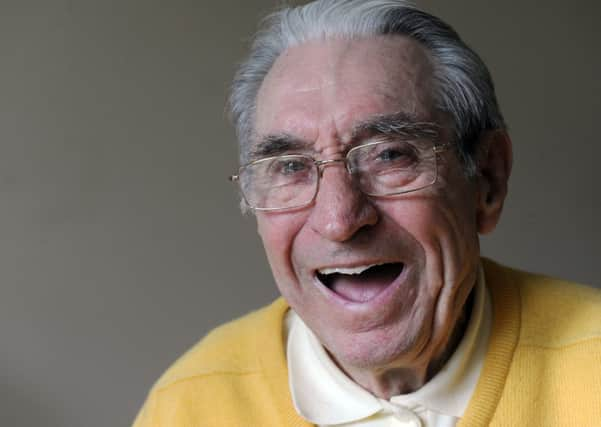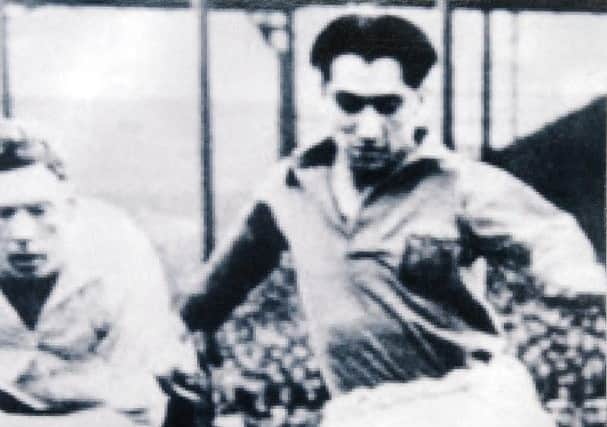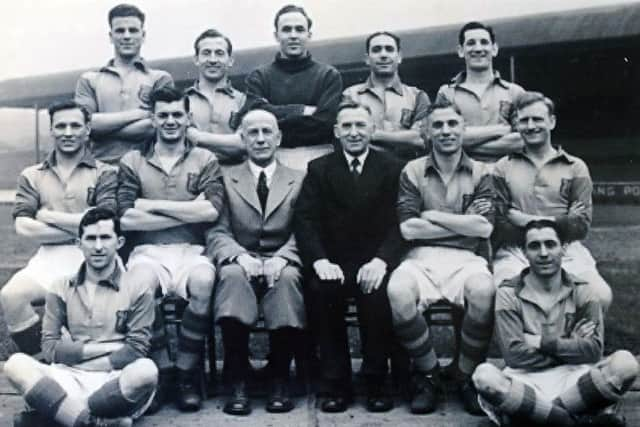The Leeds legend from another era


FROM his care home in Beeston Harold Williams is just a stone’s throw away from the hallowed turf at Elland Road, scene of some of his greatest footballing memories.
It may be more than 50 years since he last played for the club but he can still reel off the names of the team-mates who he played alongside.
Advertisement
Hide AdAdvertisement
Hide Ad“The team was Searson, Milburn and Dunn, McCabe, Charles and Burden. John Charles was centre half then, and the forward line was Cochrane, Iggleden, Browning, Dudley and Williams,” he says, his eyes lighting up at the sound of their names.


They’ve all passed away now leaving Harold, who celebrates his 90th birthday in a couple of weeks, as one of the last surviving members of a footballing generation that includes such revered icons of the game as Stanley Matthews, Tom Finney and Billy Wright. Harold, who won four caps for Wales, is also now the oldest living Welsh international footballer. But it is his eight years with Leeds United from 1949 to 1957, during which time he played 228 games and scored 35 goals, for which he’s best remembered. In his pomp he was a flying winger and the main man supplying the ammunition for the mighty John Charles to fire in the goals.
But his story begins in Wales. Born in Glamorgan in 1924, Harold showed early footballing promise but was rejected by Swansea Town after trials as a boy. Undeterred, he continued playing even managing to play during the Second World War making guest appearances for Belfast Celtic and Cliftonville.
However, the war almost put paid to his footballing career before it got started. He joined the Royal Navy in 1942 as an 18 year-old boy and served with the fleet out in the Atlantic where they fought a life and death struggle against the German U-boats. “I spent three years at sea going back and forth from Newfoundland, that was tough,” he says. “We were involved in U-boat warfare. We blew one out of the water and it came up ten yards away. It was frightening and I was very lucky to be alive.”
Advertisement
Hide AdAdvertisement
Hide AdThankfully he survived and was eventually demobbed in 1946 and went back to playing football. “My mother came home one day and said, ‘Newport County have been here for you’ and I said ‘I’m not going to Newport County.’


“I’d just come out of the Navy and I wanted to join Swansea. But even though I’d played a lot of football I was an unknown quantity at the time.”
In the end he joined Newport, which proved to be a decision that changed his life. Although a small player with tiny feet, he was blessed with great balance and blistering pace - something that Leeds United discovered to their cost when the two sides met in an FA Cup tie in 1949.
The Welsh minnows pulled off a surprise 3-1 win at Elland Road inspired by Williams, who had been up in the early hours of the day to complete his milkround before travelling to Leeds. “The player I was up against was Jimmy Milburn. He was a hard man but he wasn’t the fastest and I was too quick for him.”
Advertisement
Hide AdAdvertisement
Hide AdHis performance was so good he was snapped up by Leeds’s manager Major Frank Buckley who signed him later that summer for £12,000, a sizeable fee in those days. “It was a big thing for me because Major Buckley was possibly one of the best managers in the game at the time. What a character he was.”
Although Leeds remained in the old second division for nearly all of Harold’s time at the club, they became a strong team. “We had about five or six internationals and we were a good side.” The crowds, too, were impressive. “We got to the sixth round of the FA Cup [in the 1949/50 season] and were beaten by the Arsenal one-nil and we had regular crowds of 50,000 on the cup run.”
Harold became an integral part of the team. “What I had was speed and I could play on either wing without any problem,” he says. “I played with a lad called David Cochrane, who was a good player as well and a very close friend, and he said to me ‘will you do me a favour, will you play on the left wing?’ and I said ‘no problem.’”
Although Leeds were a Second Division club (until 1956) they arguably had Britain’s best player at the time. He and John Charles, who he calls “the big fella” were like brothers and remained close right up to Charles’s death in 2004. Harold shakes his head in awe when he talks about his friend’s footballing prowess. “He was the most brilliant footballer. He was that good I don’t think there was anyone better. He was a natural, instinctive footballer.”
Advertisement
Hide AdAdvertisement
Hide AdHe was an accomplished centre half before being unleashed further up the field to terrify defences. “He became one of the best players in the world and I couldn’t stop putting the ball on his head.”
These days football’s superstars are feted like royalty and are paid eye-watering sums of money. But it wasn’t like that in Harold’s day. His daughter, Brenda, still has a copy of one of his Leeds United contracts which shows he earned the grand sum of £12 a week. “When I finished I was on £15,” he says, out of which they had to pay their rent.
If he was playing today he’d probably earn a thousand times that. Not that he’s particularly impressed with the modern footballer. “The playing fields are in such unbelievable condition but a lot of them can only play with one foot. In my day we played with two feet.”
There’s no doubt the game has changed dramatically over the years, even the balls themselves. “I was good with the ball but it was as easy to carry the ball as it was to kick the thing.”
Advertisement
Hide AdAdvertisement
Hide AdIn the postwar period footballs were notoriously heavy and just about the only similarity between these and the Brazuca soon to be used in this summer’s World Cup is the fact they’re both round.
It’s not the only aspect of the game that’s changed for the better. Players today get criticised, and rightly so, for feigning injury, but back in the 40s and 50s some challenges bordered on assault and Harold suffered his fair share of injuries, including one tackle that left him with a broken leg and dislocated my ankle.
In 1957 he returned to Newport County and after retiring from the sport he returned to Leeds where he ran the Railway pub in Beeston, which became a popular haunt for both fans and players alike.
Now he’s getting ready for his 90th birthday and although he’s a little unsteady on his feet he’s well looked after at the care home where his family regularly come to see him.
Advertisement
Hide AdAdvertisement
Hide AdHe looks back on his career with great fondness. “It was an outstanding part of my life and I loved it,” he says, his eyes lighting up again.
The glamour and excitement of the World Cup may be just around the corner but football is also about memories, it’s about childhood heroes and players like Harold Williams.
Factfile
• Born June 17, 1924, Briton Ferry, Glamorgan.
• Joined the Royal Navy in 1942 as an 18 year-old and was part of the Atlantic convoys fighting the German U-boats.
• He was demobbed in 1946 and joined Newport County in November that year.
Advertisement
Hide AdAdvertisement
Hide Ad• Leeds United manager Major Buckley signed in 1949 for £12,000.
• He quickly struck up a rapport both on and off the pitch with fellow Welshman John Charles.
• He played for the club until March 1957, during which time he played 228 games and scored 35 goals.
• Williams was capped four times by Wales.
• He celebrates his 90th birthday this month.